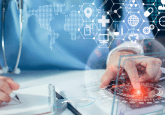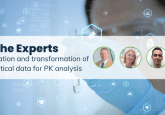Emerging technologies in patient-centric healthcare information systems

Pantea Keikhosrokiani is a Senior Lecturer at the School of Computer Sciences, Universiti Sains Malaysia (USM; Penang, Malaysia). She was a teaching fellow at the National Advanced IPv6 Centre of Excellence (Nav6), USM. She received her PhD in Service System Engineering from the School of Computer Sciences, USM. She has particularly focused on developing and integrating mobile healthcare information systems to provide location-based healthcare monitoring services for patients affected by arrhythmia and hypertension. Her articles have been published in distinguished edited books and journals including Elsevier (Telematics & Informatics), Springer, Taylor and Francis and IGI global, and have been indexed by ISI, Scopus and PubMed. She also worked as a teaching assistant at the School of Computer Sciences, USM, as part of her duty for the prestigious USM Fellowship, which was granted to her for 3 years starting from 2013.
What are the internet of things and big data technologies?
Due to lack of nursing and medical personnel, healthcare providers seek new solutions to improve patient-centered care. Advancements in new technologies revolutionized the way healthcare providers implemented patient‐centered care, resulting in the emergence of a patient-centric healthcare information system (PCHIS). The PCHIS is a system that provides ubiquitous healthcare services to patients anytime and anywhere. In order to support patients’ needs, it is important that physicians, healthcare professionals, patients and their relatives alike are all engaged in PCHIS [1]. Currently, these systems are booming at an increasing rate due to the introduction of the internet of things (IoT) and big data technologies (BDT) in healthcare. The IoT is a network of devices interacting with one another without human-to-human or human-to-computer interactions. There are numerous IoT-based applications in healthcare such as smart sensors, medical devices, remote monitoring and tracking, which can improve patient health and safety and increase satisfaction and engagement, enhancing the way healthcare providers deliver patient-centric care. However, managing the number of devices and large amounts of data can be a challenge for healthcare providers. Sets of complex data in healthcare, that cannot be analyzed by the traditional data processing software, are called healthcare big data. Different technologies, which can handle big data from storing, to analytics and decision-making are called BDT. As healthcare is a data-driven science, it can benefit from current advances in BDT and analytics, however, there are still certain challenges that need to be addressed in applying BDT and analytics to healthcare. Privacy and security of medical data are the primary concerns for the use of BDT in healthcare, with correct allocation of data for a particular purpose providing another obstacle.
Emerging IoT-based technologies offer various services to PCHISs that can improve treatment such as reliable access to medical data, transmission of biomedical signals and medical data, monitoring patients remotely and tracking patients’ location for quick emergency services. Wearable technologies inspired the way that IoT is applied to healthcare. These enable users to interact with other tools around them that can be used for self-managing and monitoring health, preventing abnormal health conditions and sending their medical data to the respective parties [2,3]. Aside from wearable technologies, IoT-based innovations in healthcare can also importantly provide continuous monitoring of patients to keep individuals out of hospital, recognize potential health issues and offer care before the situation gets worse.
The IoT and BDT are complementary technologies for healthcare. For instance, patient-generated data from IoT devices need to be analyzed by advanced healthcare big data analytic techniques to create the most appropriate medical decision based on a patient’s situation. Such patient-generated data from IoT devices include; blood pressure, heart rate, fitness results, electrocardiograms, blood glucose levels, blood oxygen saturation, dyskinesia and Parkinson’s symptoms. Use of the IoT in PCHISs is particularly attractive to aging populations and those diagnosed with chronic diseases. Patients with conditions such as Parkinson’s disease or diabetes can be monitored at home instead of in the hospital to reduce the strain on medical resources. In addition, better access to healthcare can be provided to rural areas and specifically the elderly allowing them to live more independently. Patients, healthcare staff, inventories and drugs can be tracked to monitor everyday-activities in hospitals or healthcare centers, with on-time alerts available in critical situations to improve patient-centric care. As well as this, the IoT can be used to track and monitor medical assets. In this way, medical staff require less time to search for the appropriate device and have more time for their patients. Moreover, the IoT can help to ensure critical medical devices are ready to be used and to track the various uses of medical equipment.
Challenges of the IoT and BDT
There are some disadvantages for IoT-based PCHISs such as the security risk of storing large amounts of sensitive data in one database, the accuracy risk of medical sensors or wearables for measuring patients’ biomedical data, the risk of disconnection from PCHISs and battery life issues. Fortunately, these issues are solvable and there are already many existing solutions that are being used to overcome them. Nevertheless, some issues such as the effect of motion on medical sensors, secure communications, secure data storage using cloud technologies, and processing healthcare big data need more consideration for the continued improvement of IoT-based PCHISs. Use of the IoT will likely be more pervasive in the future and next-generation IoT devices could be used to provide real-time data processing, intelligent services and decision making. Smart beds, smart homes for healthcare, patients’ recognition and prescriptions are some possible services that may be provided by next-generation IoT devices. Finally, healthcare devices could be connected to form ‘internet of healthcare things’ [4].
Healthcare big data refers to a large or complex electronic health data sets that cannot be processed by the traditional data processing software [5,6]. This includes physiological, behavioral, molecular, clinical, environmental exposure, medical imaging, disease management, medication prescription history, nutrition, or exercise parameters. There are various heterogeneous sources for healthcare big data such as electronic medical records, diagnostics, biomarkers, ancillary, medical claims, prescription claims, clinical trials, social media, wearables and sensors [5]. BDT can be used to analyze complex healthcare data in a process known as healthcare big data analytics. Some of the big data analytical techniques include cluster analysis, data mining, graph analytics, machine learning, natural language processing, neural networks, pattern recognition and spatial analysis. As healthcare is data-driven, PCHISs can benefit from current advances in BDT, however, there are certain challenges and requirements that need to be answered for healthcare big data analytics. For instance, multi-model data, which may come from electronic health records, complex background knowledge from multi-level patient, highly qualified end-users such as doctors, clinical researchers and bio-informaticians; supporting complex decisions such as the analysis of imaging data, pathology, intensive care monitoring, or the treatment of multi-morbidities; and privacy are the main concerns of BDT [7]. BDT can be used in PCHIS in different areas such as genomics, drug discovery and clinical research, personalized healthcare, precision medicine, elderly care, mental health, cardiovascular disease, diabetes, gynecology, nephrology, oncology, ophthalmology and urology. BDT creates valuable insights for patient-centric healthcare systems as they can prevent medication errors by analyzing patients’ data, help early detection of disease, recognizes high-risk patients, help accurate prediction of disease, offer patient-centric care, prevent security fraud, reduce cost and hospital visits and increase patient engagement in the healthcare system. BDT help healthcare organizations to personalize their predictions, focus on target-based treatments, provide cost-effective care, reduce waste of resources, cater patient-centric decision support systems and encourage patients. Although BDT have many advantages, healthcare organizations are concerned about the adaption of BDT and are confused about the allocation of each healthcare big data set for specific purposes – they need more knowledge to identify which data to use and for what purpose.
The future of the IoT and BDT
Due to decision making authority, technology can never completely replace humans especially in healthcare; however, technology-dependent solutions can simplify the way humans work and make them more efficient. Lack of medical resources and advancements of new technologies open a new horizon in the healthcare industry. The IoT, which is considered a connection of devices to capture, monitor and transfer data, creates a noticeable impact in healthcare. Furthermore, BDT, used to analyze healthcare complex data, are an appropriate solution for healthcare organizations using raw data for various purposes. The IoT and BDT are correlated since the IoT is one of the largest markets for big data applications. The IoT along with BDT transform the way PCHISs track patients’ records, monitor patients, treat patients and assist high-risk patients. These two new technologies reduce the number of hospital visits, decrease cost, reduce strain on hospital resources and increase quality of care, and therefore, reduce the pressure on current healthcare systems. Furthermore, BDT and IoT can provide remote healthcare services in rural areas and remote assistance accessible for a patient‘s relatives to take care of them at home. Although, IoT and BDT improve PCHISs, they have significant drawbacks such as security risks of storing, transferring and protecting medical data. Fortunately, these are being addressed by many researchers and appear solvable. On the other hand, some issues of new technologies need more consideration for the future of PCHISs; for example, the effect of motion on medical sensors. In order to adapt the IoT in healthcare, storing, managing and securing data are required. Lack of electronic health record integration is another issue of IoT-based healthcare which needs to be improved in the future, whilst BDT need more security solutions and more purposeful allocation of data. The purpose of each set of healthcare big data must be clear before storing, assortment and analytics stages. Finally, training and infrastructure among healthcare providers is required to improve the use of the IoT and BDT in healthcare if they are to be successfully implemented in the future.
[1] Keikhosrokiani P, Mustaffa N & Zakaria N. Success factors in developing iHeart as a patient-centric healthcare system: A multi-group analysis. Telemat. Inform. 35(4), 753–775 (2018).
[2] Baker SB, Xiang W & Atkinson I. Internet of things for smart healthcare: technologies, challenges, and opportunities. IEEE Access, 5, 26521–26544 (2017).
[3] Metcalf D, Milliard STJ, Gomez M & Schwartz M. Wearables and the internet of things for health: wearable, interconnected devices promise more efficient and comprehensive health care. IEEE Pulse, 7(5), 35–39 (2016).
[4] Internet of Things (IoT) in healthcare: benefits, use cases and evolutions. www.i-scoop.eu/internet-of-things-guide/internet-things-healthcare/ (2019)
[5] Mehta N & Pandit A. Concurrence of big data analytics and healthcare: A systematic review. Int. J. Med. Inform. 114, 57–65 (2018).
[6] Raghupathi W & Raghupathi V. Big data analytics in healthcare: promise and potential. Health Inf. Sci.Syst. 2(1), 3 (2014).
[7] Heinrich A, Lojo A, González AR et al. Big data technologies in healthcare: Needs, opportunities and challenges. Big Data Value Association (2016).
If you’re interested in patient-centric sampling, you might also enjoy this editorial
Our expert opinion collection provides you with in-depth articles written by authors from across the field of bioanalysis. Our expert opinions are perfect for those wanting a comprehensive, written review of a topic or looking for perspective pieces from our regular contributors.
See an article that catches your eye? Read any of our Expert Opinions for free.






